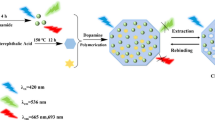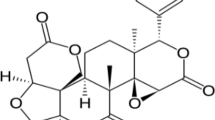Abstract
Bisphenol A (BPA), an important endocrine disrupting compound, has infiltrated human daily lives through electronic devices, food containers, and children’s toys. Developing of novel BPA assay methods with high sensitivity holds tremendous importance in valuing the pollution state. Here, we constructed an ultrasensitive photoelectrochemical (PEC) aptasensor for BPA determination by regulating photoactivities of CdS/Ni-based metal–organic framework (CdS/Ni-MOF) with [Ru(bpy)2dppz]2+ sensitizer. CdS/Ni-MOF spheres exhibited excellent photocatalytic performance, serving as a potential sensing platform for the construction of target recognition process. [Ru(bpy)2dppz]2+ were embedded into DNA double-stranded structure, functioning as sensitizer for modulating the signal response of the developed PEC aptasensor. The proposed PEC sensor exhibited outstanding analytical performances, including a wide linear range (0.1 to 1000.0 nM), low detection limit (0.026 nM, at 3σ/m), excellent selectivity, and high stability. This work provides a perspective for the design of ideal photosensitive materials and signal amplification strategies and extends their application in environment analysis.
Graphical Abstract







Similar content being viewed by others
Data Availability
The authors declare that all data generated or analyzed during this study are included in this published article (and its supplementary information files).
References
Yang J-J, Shen Y-Z, Wang Z, Zhou B, Hu X-Y, Xu Q (2023) β-Bi2O3 nanosheets functionalized with bisphenol A synthetic receptors: a novel material for sensitive photoelectrochemical platform construction. Nanomaterials 13(5):915. https://doi.org/10.3390/nano13050915
Chen Z, Duan Y, Li Z, Zhang Y, Lin L, Cao T, Yao K (2023) MoS2 grown on hollow carbon nanospheres as photoanode for improved photoelectrocatalytic degradation of Bisphenol A. J Clean Prod 404:136929. https://doi.org/10.1016/j.jclepro.2023.136929
Deiminiat B, Rounaghi GH (2021) A novel visible light photoelectrochemical aptasensor for determination of bisphenol A based on surface plasmon resonance of gold nanoparticles activated g-C3N4 nanosheets. J Electroanal Chem 886:1572–6657. https://doi.org/10.1016/j.jelechem.2021.115122
Cai G, Yu Z, Tang D (2020) Actuating photoelectrochemical sensing sensitivity coupling core-core-shell Fe3O4@C@TiO2 with molecularly imprinted polypyrrole. Talanta 219:121341. https://doi.org/10.1016/j.talanta.2020.121341
Razavipanah I, Rounaghi GH, Deiminiat B, Damirchi S, Abnous K, Izadyar M, Khavani M (2019) A new electrochemical aptasensor based on MWCNT-SiO2@Au core-shell nanocomposite for ultrasensitive detection of bisphenol A. Microchem J 146:1054–1063. https://doi.org/10.1016/j.microc.2019.02.018
Ensafi AA, Amini M, Rezaei B (2018) Molecularly imprinted electrochemical aptasensor for the attomolar detection of bisphenol A. Microchim Acta 185(5):265. https://doi.org/10.1007/s00604-018-2810-x
Najafi R, Amjadi M, Hallaj T, Narimani S (2023) A dual chemiluminescence and ratiometric fluorescence sensor based on WS2 QDs- Fe(II)- S2O82− system for bisphenol A detection. Opt Mater 144:0925–3467. https://doi.org/10.1016/j.optmat.2023.114320
Yin W, Wu L, Ding F, Li Q, Wang P, Li J, Lu Z, Han H (2018) Surface-imprinted SiO2@Ag nanoparticles for the selective detection of BPA using surface enhanced Raman scattering. Sens Actuators B Chem 258:566–573. https://doi.org/10.1016/j.snb.2017.11.141
Wan S, Xu O, Song H, Yang J, Zhu X (2022) Imidazole ionic liquid functionalized ZIF-67 molecularly imprinted solid-phase extraction coupled with high performance liquid chromatography for analysis of bisphenol A. Anal Methods 14(19):1904–1912. https://doi.org/10.1039/d2ay00359g
Owczarek K, Waraksa E, Kłodzińska E, Zrobok Y, Ozimek M, Rachoń D, Kudłak B, Wasik A, Mazerska Z (2022) Validated GC–MS method for determination of bisphenol a and its five analogues in dietary and nutritional supplements. Microchem J 180:107643. https://doi.org/10.1016/j.microc.2022.107643
Hou C, Zhao L, Geng F, Wang D, Guo LH (2016) Donor/acceptor nanoparticle pair-based singlet oxygen channeling homogenous chemiluminescence immunoassay for quantitative determination of bisphenol A. Anal Bioanal Chem 408(30):8795–8804. https://doi.org/10.1007/s00216-016-9584-y
Chen J, Huang X, Ye R, Huang D, Wang Y, Chen S (2022) Fabrication of a novel electrochemical sensor using conductive MOF Cu-CAT anchored on reduced graphene oxide for BPA detection. J Appl Electrochem 52(11):1617–1628. https://doi.org/10.1007/s10800-022-01735-5
Xin F-F, Xu J-J, Zhang J, Wang A-J, Xue Y, Mei L-P, Song P, Feng J-J (2023) Nanozyme-assisted ratiometric photoelectrochemical aptasensor over Cu2O nanocubes mediated photocurrent-polarity-switching based on S-scheme FeCdS@FeIn2S4 heterostructure. Biosens Bioelectron 237:115442. https://doi.org/10.1016/j.bios.2023.115442
Xu J-J, Xu B-F, Qu P, Wang A-J, Mei L-P, Song P, Feng J-J, Cheang TY, Lin W (2023) Target-induced in situ competitive absorption: a new strategy for photoelectrochemical aptasensing towards zearalenone based on CdS/ethylenediamine 3D nanowires network with sulfur vacancies. Sens Actuators B Chem 394:134434. https://doi.org/10.1016/j.snb.2023.134434
Huang J, Li X, Xiu M, Huang K, Cui K, Zhang J, Ge S, Hao S, Yu J, Huang Y (2022) A paper-based photoelectrochemical sensing platform based on in situ grown ZnO/ZnIn2S4 heterojunctions onto paper fibers for sensitively detecting AFP. Biosensors 12(10):2079–6374. https://doi.org/10.3390/bios12100818
Li B, Guo L, Chen M, Guo Y, Ge L, Kwok HF (2022) Single-atom Pt-anchored Zn0.5Cd0.5S boosted photoelectrochemical immunoassay of prostate-specific antigen. Biosens Bioelectron 202:0956–5663. https://doi.org/10.1016/j.bios.2022.114006
Shi W, Li W, Nguyen W, Chen W, Wang J, Chen M (2022) Advances of metal organic frameworks in analytical applications. Mater Today Adv 15:2590–498. https://doi.org/10.1016/j.mtadv.2022.100273
Freund R, Zaremba O, Arnauts G, Ameloot R, Skorupskii G, Dincă M, Bavykina A, Gascon J, Ejsmont A, Goscianska J, Kalmutzki M, Lächelt U, Ploetz E, Diercks CS, Wuttke S (2021) The current status of MOF and COF applications. Angew Chem Int Ed 60(45):23975–24001. https://doi.org/10.1002/anie.202106259
Pan Y, Han Y, Chen Y, Li D, Tian Z, Guo L, Wang Y (2022) Benzoic acid-modified 2D Ni-MOF for high-performance supercapacitors. Electrochim Acta 403:0013–4686. https://doi.org/10.1016/j.electacta.2021.139679
Tang J, Ma X, He J, Liu X, Li M (2022) Zr (IV) metal-organic framework based cadmium sulfide for enhanced photocatalytic water splitting. J Environ Chem Eng 10(3):2213–3437. https://doi.org/10.1016/j.jece.2022.107820
Dong W, Li Z, Wen W, Liu B, Wen G (2021) Novel CdS/MOF cathodic photoelectrochemical (PEC) platform for the detection of doxorubicin hydrochloride and gentamicin sulfate. ACS Appl Mater Interfaces 13(48):57497–57504. https://doi.org/10.1021/acsami.1c19481
Shi Y, Li T, Zhao L, Liu Y, Ding K, Li D, He P, Jiang D, Liu J, Zhou H (2023) Ultrathin MXene nanosheet-based TiO2/CdS heterostructure as a photoelectrochemical sensor for detection of CEA in human serum samples. Biosens Bioelectron 230:115287. https://doi.org/10.1016/j.bios.2023.115287
Seok Kim Y, Ahmad Raston NH, Bock GuM (2016) Aptamer-based nanobiosensors. Biosens Bioelectron 76:2–19. https://doi.org/10.1016/j.bios.2015.06.040
Zhang W, He Y, Feng Z, Zhang J (2022) Recent advances of functional nucleic acid-based sensors for point-of-care detection of SARS-CoV-2. Microchim Acta 189(3):128. https://doi.org/10.1007/s00604-022-05242-4
Liu R, He L, Hu Y, Luo Z, Zhang J (2020) A serological aptamer-assisted proximity ligation assay for COVID-19 diagnosis and seeking neutralizing aptamers. Chem Sci 11(44):12157–12164. https://doi.org/10.1039/d0sc03920a
Shin W-R, Ahn G, Lee J-P, Oh I-H, Ahn J-Y, Kim Y-H, Chae S (2023) Recent advances in engineering aptamer-based sensing and recovery of heavy metals and rare earth elements for environmental sustainability. Chem Eng J 472:144742. https://doi.org/10.1016/j.cej.2023.144742
Xiang J, Zhang J, Liao L, Jiang B, Yuan R, Xiang Y (2023) Label-free and sensitive fluorescent sensing of ten-eleven translocation enzyme via cascaded recycling signal amplifications. Anal Chim Acta 1251:341025. https://doi.org/10.1016/j.aca.2023.341025
Lei J, Han B, Lv S, Li Y, Tang J, Mao Y, Zhuang J (2018) Magneto-controlled photoelectrochemical sensor for sensitive monitoring of telomerase activity based on removal of electron acceptors mediated by G-quadruplex/hemin complexes. Electrochem Commun 92:43–47. https://doi.org/10.1016/j.elecom.2018.05.023
Wu R, Xin T, Wang Y, Wang T, Liu L, Hao J (2022) A lateral built-in field of the 2D/2D SnS2/SnSe2 in-plane heterostructure with boosted interfacial charge transfer. J Mater Chem A 10(28):14810–14819. https://doi.org/10.1039/d2ta03333j
Wang G-Q, Wei J-J, Ye J-Y, Wang A-J, Mei L-P, Feng J-J (2023) A signal-off photoelectrochemical aptasensor for highly sensitive detection of T-2 toxin using 3D CdS/CdIn2S4 heterostructured nanostars by in-situ generated electron donor strategy. Sens Actuators B Chem 381:0925–4005. https://doi.org/10.1016/j.snb.2023.133421
Zhao W-W, Xu J-J, Chen H-Y (2015) Photoelectrochemical bioanalysis: the state of the art. Chem Soc Rev 44(3):729–741. https://doi.org/10.1039/c4cs00228h
Xu M, Sun C, Zhao X, Jiang H, Wang H, Huo P (2022) Fabricated hierarchical CdS/Ni-MOF heterostructure for promoting photocatalytic reduction of CO2. Appl Surf Sci 576:0169–4332. https://doi.org/10.1016/j.apsusc.2021.151792
Guo J, Liang Y, Liu L, Hu J, Wang H, An W, Cui W (2020) Noble-metal-free CdS/Ni-MOF composites with highly efficient charge separation for photocatalytic H2 evolution. Appl Surf Sci 522:146356. https://doi.org/10.1016/j.apsusc.2020.146356
Liu C, Liu Y, Xiang Z, Liu D, Yang Q (2021) Bimetallic MOF-derived sulfides with heterojunction interfaces synthesized for photocatalytic hydrogen evolution. Ind Eng Chem Res 60(30):11439–11449. https://doi.org/10.1021/acs.iecr.1c01838
Tu LH, Zhu JH, Tanjung AP, Wang M, Kang J, Wang AJ, Mei LP, Xue Y, Song P (2022) A signal-off photoelectrochemical aptasensor for ultrasensitive 17beta-estradiol detection based on rose-like CdS@C nanostructure and enzymatic amplification. Microchim Acta 189(2):56. https://doi.org/10.1007/s00604-022-05164-1
Miao Y-f, Guo R-t, Gu J-w, Liu Y-z, Wu G-l, Duan C-p, Zhang X-d, Pan W-g (2020) Fabrication of β-In2S3/NiAl-LDH heterojunction photocatalyst with enhanced separation of charge carriers for efficient CO2 photocatalytic reduction. Appl Surf Sci 527:146792. https://doi.org/10.1016/j.apsusc.2020.146792
Li X, Bai Y, Shi X, Huang J, Zhang K, Wang R, Ye L (2021) Mesoporous g-C3N4/MXene (Ti3C2Tx) heterojunction as a 2D electronic charge transfer for efficient photocatalytic CO2 reduction. Appl Surf Sci 546:149111. https://doi.org/10.1016/j.apsusc.2021.149111
Mao C, Wu L, Wen Y, Tang X, Huang Z, Zhao L (2023) Photoelectrochemical immunosensor for carcinoembryonic antigen detection-an attempt for early cancer screening. Biosens Bioelectron 220:114918. https://doi.org/10.1016/j.bios.2022.114918
Xu B-F, Li Q, Qu P, Xin X-R, Wang A-J, Mei L-P, Song P, Feng J-J (2023) Magnetic-assisted exciton-plasmon interactions modulated Bi2S3 nanorods@MoS2 nanosheets heterojunction: towards a split-type photoelectrochemical sensing of profenofos. Microchim Acta 190(9):350. https://doi.org/10.1007/s00604-023-05927-4
Xie Y, Ma L, Ling S, Ouyang H, Liang A, Jiang Z (2022) Aptamer-adjusted carbon dot catalysis-silver nanosol SERS spectrometry for bisphenol A detection. Nanomaterials 12(8):2079–4991. https://doi.org/10.3390/nano12081374
Kim M-Y, Seo K-D, Park H, Mahmudunnabi RG, Hwan Lee K, Shim Y-B (2022) Graphene-anchored conductive polymer aerogel composite for the electrocatalytic detection of hydrogen peroxide and bisphenol A. Appl Surf Sci 604:0169–4332. https://doi.org/10.1016/j.apsusc.2022.154430
Zhu Y, Gu X, Jiang F, Jia R, Jin M, Chen M, Zhang G (2018) Ultrasensitive detection of bisphenol A based on an aptasensor with DNA amplification. Food Agric Immunol 29(1):1106–1115. https://doi.org/10.1080/09540105.2018.1515893
Wang L, Cao HX, Pan CG, He YS, Liu HF, Zhou LH, Li CQ, Liang GX (2018) A fluorometric aptasensor for bisphenol a based on the inner filter effect of gold nanoparticles on the fluorescence of nitrogen-doped carbon dots. Microchim Acta 186(1):28. https://doi.org/10.1007/s00604-018-3153-3
Liu X, Wang T, Wang Y (2023) Selective and ratiometric fluorescence sensing of bisphenol A in canned food based on portable fluorescent test strips. Anal Chim Acta 1240:340728. https://doi.org/10.1016/j.aca.2022.340728
Zhang Y, Zhang W, Zhang L, Song G, Wang N, Xu W, Huang W (2021) A molecularly imprinted electrochemical BPA sensor based on multi-walled carbon nanotubes modified by CdTe quantum dots for the detection of bisphenol A. Microchem J 170:106737. https://doi.org/10.1016/j.microc.2021.106737
Qian H, Wang J, Yan L (2020) Synthesis of lignin-poly(N-methylaniline)-reduced graphene oxide hydrogel for organic dye and lead ions removal. J Bioresour Bioprod 5(3):204–210. https://doi.org/10.1016/j.jobab.2020.07.006
Funding
This research was supported by Natural Science Foundation of Zhejiang Province (LQ22B050006), National Natural Science Foundation of China (22204143), China Postdoctoral Science Foundation (2022M722827), and the Open Fund Project of Key Laboratory of Watershed Surface Process and Ecological Security of Zhejiang Normal University (KF-2022–14).
Author information
Authors and Affiliations
Corresponding authors
Ethics declarations
Competing interests
The authors declare no competing interests.
Additional information
Publisher's Note
Springer Nature remains neutral with regard to jurisdictional claims in published maps and institutional affiliations.
Supplementary information
Below is the link to the electronic supplementary material.
Rights and permissions
Springer Nature or its licensor (e.g. a society or other partner) holds exclusive rights to this article under a publishing agreement with the author(s) or other rightsholder(s); author self-archiving of the accepted manuscript version of this article is solely governed by the terms of such publishing agreement and applicable law.
About this article
Cite this article
Tanjung, A.P., Yin, K., Zhao, L. et al. Target-regulated photoactivities of CdS/Ni-MOF heterojunction with [Ru(bpy)2dppz]2+ intercalator: a bisphenol A photoelectrochemical aptasensor. Microchim Acta 191, 139 (2024). https://doi.org/10.1007/s00604-024-06230-6
Received:
Accepted:
Published:
DOI: https://doi.org/10.1007/s00604-024-06230-6




